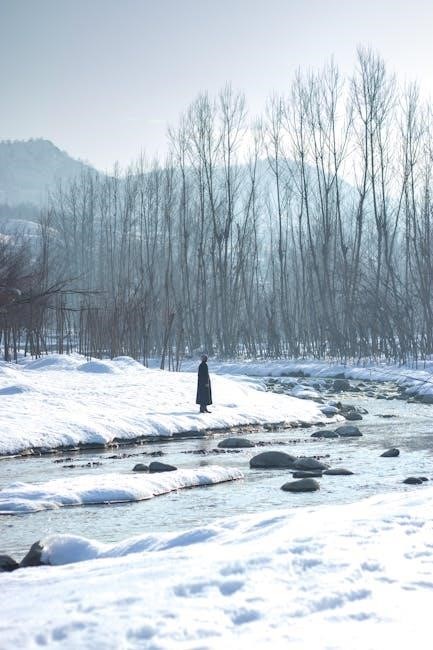The Frozen River, a gripping historical mystery by Ariel Lawhon, unfolds in 18th-century Maine․ Martha Ballard, a midwife, investigates a murder, blending fact and fiction through a feminist lens․ The novel explores themes of social injustice and gender roles, set against the harsh backdrop of frontier life․
1․1 Overview of the Novel and Its Historical Context
The Frozen River, a historical fiction thriller by Ariel Lawhon, is set in 1789 Maine and centers around Martha Ballard, a midwife and diarist, who investigates a murder while navigating societal norms and injustices․ Based on real historical figures and events, the novel draws inspiration from Martha Ballard’s diary, which provides a detailed account of life in 18th-century Maine․

- The story begins with the discovery of a frozen body in the Kennebec River, identified as Joshua Burgess, a man accused of raping Rebecca Foster․
- Martha’s investigation reveals evidence of murder, challenging the community’s acceptance of authority and gender roles․
- Historical context is woven into the narrative, including the harsh winter of 1789-1790 and the social tensions of frontier life․
- The novel blends fact and fiction, incorporating real figures like Colonel Joseph North, who was accused of rape, and Martha Ballard, a midwife who delivered over 800 babies․
The historical backdrop of Hallowell, Maine, and the Kennebec River plays a crucial role in shaping the story’s themes of injustice, truth, and resilience․ Lawhon’s meticulous research ensures authenticity, making the novel a compelling blend of mystery and historical insight․

1․2 Importance of Character Analysis in The Frozen River
Character analysis is essential to understanding the depth and complexity of The Frozen River․ Martha Ballard, the protagonist, emerges as a strong, observant woman whose midwifery skills and diary entries provide a unique lens into 18th-century life․ Her investigation into Joshua Burgess’s murder reveals her resilience and determination to challenge authority and societal norms․
- Martha Ballard represents a woman navigating a male-dominated world, using her knowledge and experience to uncover truths others ignore․
- Rebecca Foster, a victim of sexual assault, symbolizes the vulnerability of women in a patriarchal society, while Joseph North embodies the corruption of power․
- Dr․ Benjamin Page contrasts with Martha, highlighting the clash between male authority and female intuition․
- Martha’s family, including her husband Ephraim and children, add layers to her character, showing her balancing personal life with her duties․

Through these characters, the novel explores themes of justice, gender roles, and resilience․ Their interactions and conflicts drive the plot, making character analysis vital for grasping the novel’s historical and emotional depth․
Main Characters and Their Roles
Martha Ballard, the midwife and protagonist, investigates a murder while navigating societal norms․ Her family, including Ephraim, Cyrus, Jonathan, Hannah, and Dolly, supports her journey․ Dr․ Benjamin Page and Colonel Joseph North represent authority and corruption, while Rebecca Foster and Joshua Burgess embody tragedy and injustice․

2․1 Martha Ballard: The Protagonist and Her Family
Martha Ballard is the protagonist, a resilient midwife living in 18th-century Hallowell, Maine․ Known for her meticulous diary and unwavering dedication, Martha has delivered over 800 babies without losing a mother․ Her husband, Ephraim Ballard, supports her tirelessly, while their children—Cyrus, Jonathan, Hannah, and Dolly—navigate their own challenges․ Cyrus, the eldest, faces suspicion in a murder investigation, while Jonathan struggles with personal secrets, including an illegitimate child with Sally Pierce․ Hannah and Dolly explore courtships with local suitors, adding layers to the family dynamics․ Martha’s diary serves as a crucial narrative tool, documenting her observations and the town’s events․ Her role as a midwife grants her unique insight into the community, making her a formidable investigator․ Despite societal constraints, Martha’s strength and intuition drive her to seek justice, even when it endangers her family․ The Ballard family’s resilience and interconnected lives form the emotional core of the novel, highlighting themes of family, duty, and survival in a harsh frontier setting․

2․2 Key Supporting Characters: Their Significance in the Plot
The novel is enriched by a cast of supporting characters who play pivotal roles in advancing the plot and deepening the narrative․ Dr; Benjamin Page, a Harvard-educated physician, represents the clash between traditional male authority and Martha’s practical experience․ His dismissal of Martha’s findings underscores the gender biases of the time․ Colonel Joseph North, a powerful landowner, is a central antagonist accused of rape and corruption․ His influence and threats escalate the tension, testing Martha’s courage․ Rebecca Foster, the victim of North’s alleged assault, is a tragic figure whose story drives Martha’s quest for justice․ Sam Stone, a local man, becomes entangled in the mystery of Burgess’s death, revealing a personal vendetta that adds complexity to the plot․ Jonathan Burgess, the victim, is portrayed as a troubled figure whose actions have far-reaching consequences․ Sally Pierce, a former maid, introduces a subplot involving an illegitimate child, further intertwining the community’s secrets․ Each character’s actions and motivations contribute to the novel’s exploration of justice, power, and societal norms, making them indispensable to the story’s progression․

Themes and Symbolism in The Frozen River

The novel delves into themes of social injustice and gender roles, highlighting the struggles of women in a patriarchal society․ The Kennebec River symbolizes both life and death, serving as a silent witness to the town’s secrets and tragedies, reflecting the broader societal tensions․
3․1 Exploration of Social Injustice and Gender Roles
The Frozen River vividly portrays the entrenched social injustices and rigid gender roles of 18th-century Maine․ Martha Ballard, as a midwife, embodies female resilience and agency in a society dominated by male authority․ Her investigation into Joshua Burgess’s murder challenges the patriarchal norms, as she confronts powerful men like Colonel Joseph North and Dr․ Benjamin Page, who dismiss her expertise․ The novel highlights the systemic oppression of women, particularly through Rebecca Foster’s harrowing experience of rape and her subsequent marginalization by the community․ Martha’s unwavering support for Rebecca underscores the strength of female solidarity in the face of injustice․ The courtroom drama further illustrates the limitations placed on women, as Rebecca’s testimony is undermined, and Martha’s diary becomes a crucial yet contested piece of evidence․ Through these narratives, the novel critiques the legal and social structures that perpetuate inequality, offering a powerful commentary on the historical mistreatment of women and the enduring struggle for justice and recognition․

3․2 The Role of the Kennebec River as a Symbol
The Kennebec River serves as a central symbol in The Frozen River, representing both life and death, transformation, and the unyielding forces of nature․ Its early and brutal freeze mirrors the rigid social structures and injustices that grip the town of Hallowell․ The river’s icy surface, where Joshua Burgess’s body is discovered, symbolizes the chilling reality of violence and secrets buried beneath the community’s surface․ As the story progresses, the river becomes a silent witness to the unfolding drama, its frozen state reflecting the emotional and social paralysis of the characters․ Yet, the eventual thawing of the river at the end of the novel signifies renewal and the return of a natural order, contrasting with the legal system’s failure to deliver justice for Rebecca Foster․ The river also embodies the resilience of frontier life, as it sustains the town even as it poses dangers․ Through its symbolic role, the Kennebec River underscores the tension between nature’s indifference and humanity’s struggle for truth and justice․

